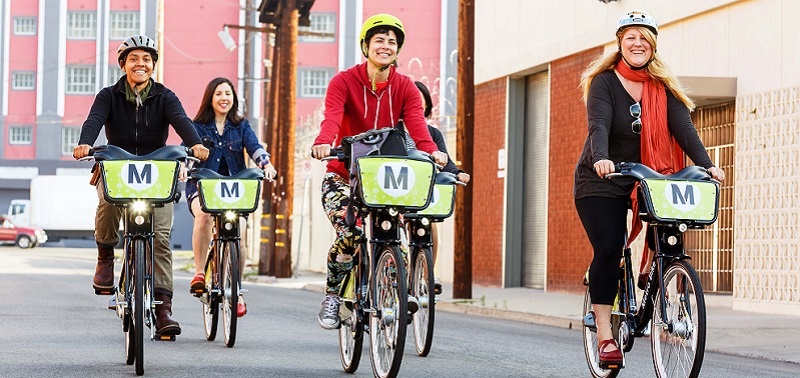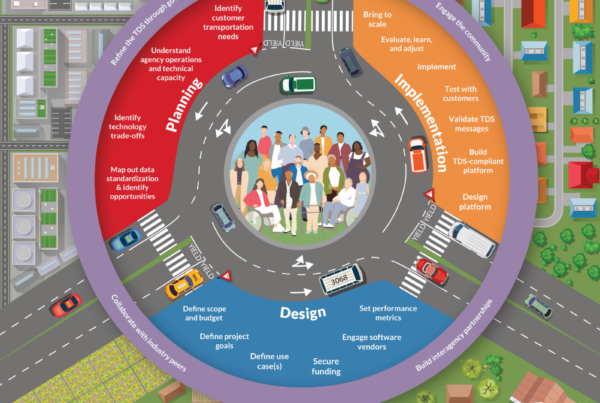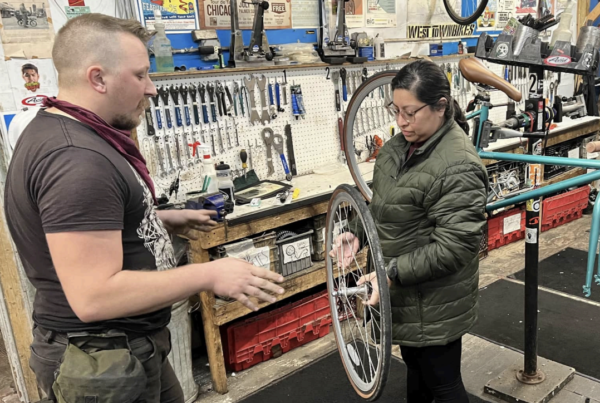Transportation leaders from the Los Angeles County Metropolitan Transportation Authority, Los Angeles Department of Transportation, the American Public Transportation Association (APTA) and representatives from Uber and Lyft joined the Shared-Use Mobility Center (SUMC) today to release a new Shared Mobility Action Plan for Los Angeles County.
Developed by SUMC with input from numerous regional stakeholders, the plan is designed to help Los Angeles County capitalize on the tremendous transportation changes taking place in the region—including the recent launch of bikesharing, unprecedented expansion of the county’s public transit system, and the initiation of new projects featuring electric carshare cars and integrated mobility hubs—and suggests ways the county can leverage this progress to further reduce reliance on private autos and expand sustainable, cost-effective modes of transport for all.
“Public transit and shared mobility together can create a robust network of choices that help reduce household transportation costs, curb fossil fuel consumption and lessen greenhouse gas emissions,” said Sharon Feigon, Executive Director of SUMC, a national public-interest organization working to foster collaboration in shared transportation. “We believe it is vital that Los Angeles County embrace the goals outlined in this plan and work to scale up transit, bikesharing, carsharing and ride-hailing to help reduce congestion on the region’s roadways and increase affordable, environmentally sound transportation options for all residents.”
“From the recent launch of Metro Bike Share to the many carsharing and ride-hailing providers now operating here, it’s clear that new forms of shared transportation are growing rapidly in Los Angeles County,” said Metro CEO Phil Washington. “The Metro Board and I recognize that public transit and shared mobility together offer a true transportation alternative to getting around the county by car, and are vital to the future of the region.”
“Los Angeles set ambitious targets in our Sustainable City pLAn to reduce greenhouse gas emissions while innovating and incubating new, environmentally friendly ways for people to get where they need to go,” said Los Angeles Mayor Eric Garcetti. “And we are delivering—with more than 1,000 publicly available EV charging stations now installed, the largest full-battery EV municipal fleet in the country, and an EV carsharing program we will soon roll out to help disadvantaged communities. L.A. is building its clean energy future today, and City Hall is committed to leading the way.”
At the heart of the Shared Mobility Action Plan for Los Angeles County is a 2 percent vehicle reduction target that, if realized, would remove 100,000 private cars from the county’s roads over the next five years as a result of dramatically scaling up shared mobility in concert with public transit.
While this may seem like a relatively modest goal, SUMC believes it has the potential to be transformative and to accelerate further change. According to SUMC’s calculations, removing 100,000 cars could help cut annual CO2 emissions by nearly 375,000 metric tons, save more than $350 million in annual household transportation costs, and result in more than 1 billion fewer vehicle miles traveled in Los Angeles County each year, significantly improving traffic congestion for those who have to drive.
SUMC estimates the region could reach this goal by adding approximately 34,000 new transit riders, 16,800 ride-splitting/carpool users, 8,400 carshare cars, and 10,000 bikeshare bikes. These expanded modes of transport can work together to fill existing service gaps, provide first/last mile connections and extend the reach of current and planned transit lines.
To support this growth, the action plan also includes a wealth of additional information, including:
- Recommended strategies based on best practices from other cities and the industry’s most innovative recent developments
- A “roadmap for action” that prioritizes tactics and implementation
- Anticipated outcomes and impacts for expanding bikesharing, carsharing, ride-splitting/carpooling and public transit
- Specific policies and funding sources that local leaders can pursue to achieve this growth
Finally, the plan suggests that significant investment, effort and collaboration will be needed from both the public and private sectors to meet the 100,000-car target and realize the promise of a greener, more affordable, and more accessible Los Angeles County. More information, along with a complete copy of the report, is available on SUMC’s website sharedusemobilitycenter.org.
Link to Shared Mobility Action Plan for Los Angeles County: http://bit.ly/sumcplanLA




